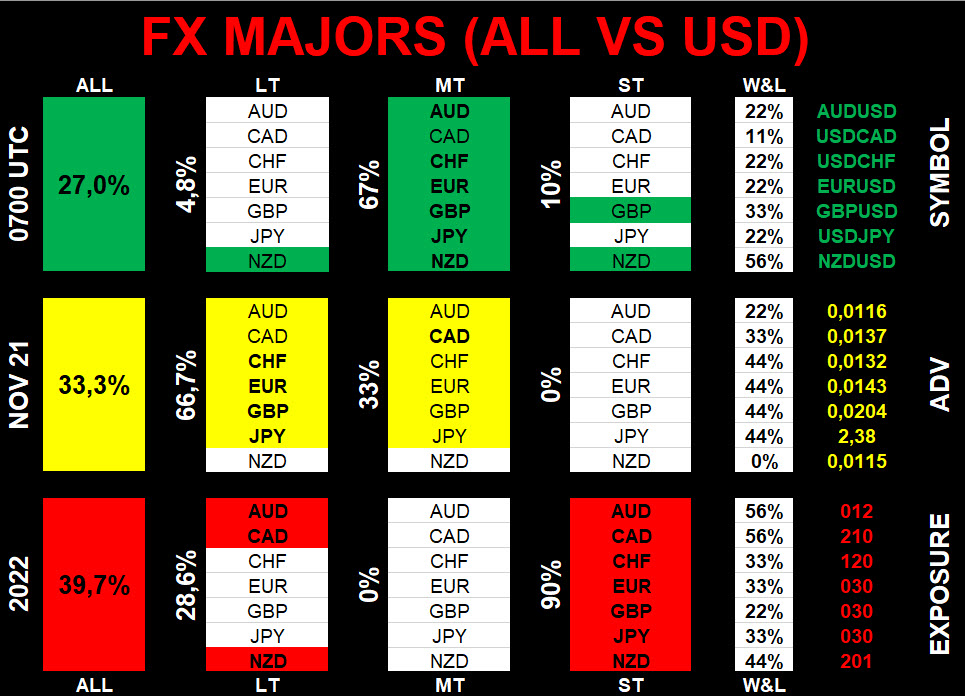Market Sentiment Indicators
In this article we will discuss the most popular indicators of market sentiment, used by traders and investors in the financial markets.
Let’s start with a definition. Market sentiment indicators are graphical or digital indicators, the main purpose of which is to show what kind of opinion a group of people has regarding the current state of the market, the business environment or any other phenomenon. Sentiment indicators seek to quantify how various factors, such as unemployment, inflation, macroeconomic conditions, and policies influence the future behavior / evolution of a phenomenon.
If we talk about the sentiment indicators in relation to the financial markets, it should be noted, that they show the general mood, or, in other words, the degree of consensus of market participants regarding the future behavior of price of a financial instrument.
What are the practical benefits of evaluating market sentiment?
It is quite obvious, that if you learn how to correctly assess the level of optimism and pessimism of investors and traders in the market, then this could be your edge in making money in the market.
For example, when bullish sentiment dominates the market, it means that the majority of market participants either have already opened or are preparing to open long positions because they believe that the price will rise further. Accordingly, when bearish sentiment dominates the market, it means that the majority of market participants either have already opened or are preparing to open short positions because they believe that the price will fall further.
However, as you know, the trees do not grow to the sky, or, in other words, the market can not be a situation where all players are buyers or sellers. Therefore, at the first sign of extreme bullish or extreme bearish sentiment, trader should think about protecting as yet unrealized profits, and possibly opening a new position in anticipation of a change in trend. Key market reversals tend to occur at times when most of the financial analysts and consultants (60% or more) are bullish or bearish. In other words, at the time when the vast majority of market participants have acknowledged the presence of trend and wants to join it, comes the end of this trend.
On the other hand, as we know, most of the time (estimates vary from ⅔ to ¾), the market stays in a state of consolidation or mild bullish or mild bearish trend. For this reason, in terms of market sentiment, the situations where a neutral or mixed sentiment (ie neutral-bullish, neutral-bearish or equally distributed) are more common in the market. In such market situations, the tactic of a trader is to identify a stronger group of players (bulls or bears) at the moment of exit from consolidation, join it and trade in accordance with the rules of his strategy in the direction of the dominant trend.
Thus, in order to understand what impact sentiment can have on the financial instrument you are trading, it is necessary to determine the general mood of all market participants. In technical trading, the main principle is to study the behavior of market participants (i. e. price and volume), and not what they say and think. In turn, in order to do this, it is essential to study the market statistics. It should be noted here that in order to get information about the mood of market participants and what they expect from the market, most sentiment indicators are not limited to just studying the price dynamics of any particular instrument or index.
Power Balance Chart
By what means can market sentiment be measured? At present, we know a lot of different types of market sentiment indicators. Moreover, in each market, whether it is the stock market, futures market or Forex market, traders and investors apply sentiment indicators unique to these markets.
In the diagram below you can see the Power Balance Chart, or, in other words, the technical indicator of market sentiment within a selected segment of the financial market – here you can see the situation within the segment of the Forex market – major currency pairs. Power Balance Chart – is the proprietary analytical product, created in the form of a graphical diagram that shows the mood of the three groups of market participants. The chart is based on the technical signals of the three proprietary trading strategies. Signals (the strength of bulls / neutrals / bears) are evaluated on a scale from 1 to 3, after which the final balance of power of market participants is calculated, which is displayed in the chart. You can learn more about how the diagram is plotted here.
The Power Balance Chart is divided into several sections, which reflect the technical picture in the financial instruments from the perspective of the selected trading strategy. As you can see, there are LT, MT and ST sections, corresponding to the long-term, medium-term and short-term market perspectives. The W&L (winners & losers) section shows the alignment of forces on each individual instrument, while the sector ALL corresponds to the total level of bullish, bearish or neutral sentiment within the selected segment of the market.
Please note that in this case the level of bullish, bearish or neutral market sentiment for a given currency pair is determined in relation to the US dollar. That is, for example, working with such currency pairs like AUDUSD, EURUSD, GBPUSD, NZDUSD, where the US dollar is the quote currency, you must remember that the prevalence of bullish sentiment over the bearish according to the balance of power means the higher probability of an increase in the value of the base currency (AUD, EUR, GBP, NZD) and vice versa. In the case of currency pairs like USDCHF, USDCAD and USDJPY, where the US dollar is the base currency, the prevalence of bullish sentiment over the bearish according to the balance of power means the higher probability of an increase in the value of the quote currency (CHF, CAD, JPY). The “Technical Profile of the Instrument” allows you to build a “Power Balance Chart” or, in other words, a heatmap of the mood of market participants (market sentiment) within an entire segment of the financial market, for example, the precious metals market, the energy market or cryptocurrencies market.
Below on the slide is the diagram which represents the balance of power within the segment of major currency pairs (FX Majors).

Likewise this chart, if necessary it is possible to determine the balance of power of market participants within the following segments of the global market: cross-rates of major currencies, precious metals, energies, crypto-currencies, grains, meats, US bonds, US stock indices, shares of individual companies in a given market sector.
How to Use Power Balance Chart?
After analyzing the power balance of market participants within the selected market segment and after determining the financial instrument which shows a noticeable advantage of bullish or bearish sentiment and provides a good opportunity for a trade, it remains to determine the technical parameters of the trade. In other words, it remains to determine the optimal levels for the position opening and closing, that could provide an acceptable level of risk and attractive P/L ratio.
As auxiliary information, the Power Balance Chart contains the parameter of the average daily volatility of a financial instrument (ADV), as well as the number of formal positions opened for each financial instrument (Exposure, Longs/Neutrals/Shorts).
In conclusion, it should be noted that the indicators of market sentiment do not give accurate signals as to when to open a position. The fact that the indicator of market sentiment reaches its extreme value does not mean that the trader must immediately start looking for opportunities to buy or sell. Indicators of market sentiment should be considered as supporting tools, indicating the preferred direction of the transaction. They can be used to decide whether it is appropriate to look for opportunities to go Long or Short, but will never tell you when to open a position. This question must be resolved with the help of traditional tools of technical and fundamental analysis. It should also be noted that the indicators of market sentiment are most effective on daily charts and larger time frames.
GMT Partner offers its customers a subscription to the Power Balance Chart for a variety of segments of the global financial market. This service is aimed at active traders and investors. To subscribe to the Power Balance Chart for selected segments of the market, please send your request here or make your order here.
DISCLAIMER:
The risk of loss in trading Forex, futures, stocks and options can be substantial and is not suitable for all investors. Past performance is not necessarily indicative of future results. GMT Partner Ltd only provides educational services. By accessing any GMT Partner Ltd content, you agree to be bound by the terms of service. Testimonials are believed to be true based on the representations of the persons providing the testimonials, but facts stated in testimonials have not been independently audited or verified. Nor has there been any attempt to determine whether any testimonials are representative of the experiences of all persons using the methods described herein or to compare the experiences of the persons giving the testimonials after the testimonials were given. The average reader should not necessarily expect the same or similar results. Past performance is not necessarily indicative of future results. No person was compensated for providing a testimonial.
